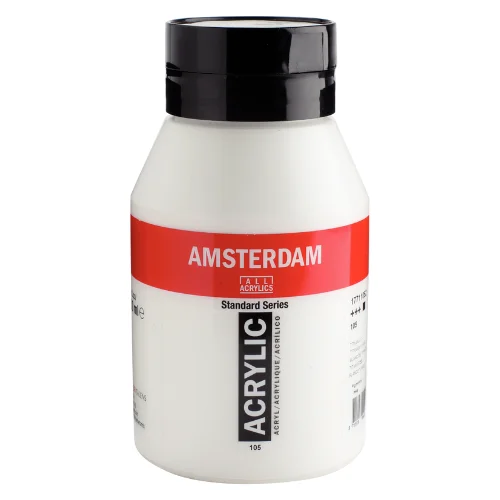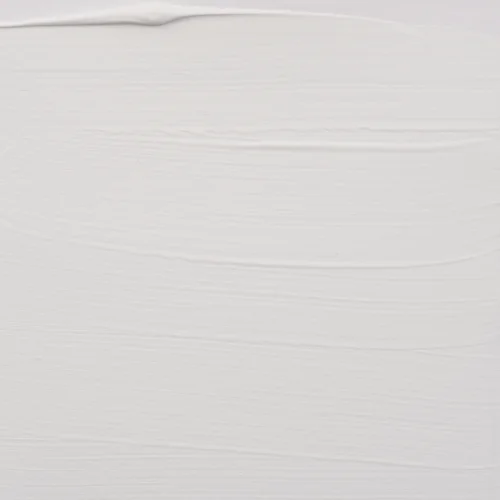Titanium White Amsterdam Acrylic Paint 1000ml
R999.00
-
-
- Royal Talens Amsterdam Acrylic Paints have a high degree of lightfastness.
- Thanks to the use of pure and non-fading pigments even after several decades the works of art retain their original colour.
- Royal Talens Amsterdam Acrylic Paints are made with an exceptionally durable paint film, the binding agent consists of 100% acrylic resin, for an everlasting result.
- These paints are alkali resistant and consequently, are suitable for wall paintings.
- The paint can be thinned easily with water.
- If applied in a thin film, paint can dry within half an hour.
- The specific preparation method makes Amsterdam Acrylics practically odourless.
- Exceptionally durable for a long-lasting result.
- Suitable for painting murals.
- No solvent is necessary.
- 90 Brilliant colours in the range (including 7 Metallics, 6 Pearls and 4 Reflex Colours).
- Amsterdam Acrylic Paint are available in 120ml tubes.
- Titanium White Amsterdam Acrylic Paint 1000ml.
-
Change the quantity above using the arrows (shown on hover) or manually input your desired amount.
Amsterdam Acrylic Paint Product Features:
Very high degree of lightfastness.
Pure, stable pigments.
Strong and flexible paint film as a 100% acrylate emulsion is used as a binder.
Exceptionally durable for a long-lasting result.
Suitable for painting murals.
Ideal for use on paper, boar, canvas, wood and stone.
No solvent is necessary.
Easy to thin with water.
Short drying time (thin layers dry within half an hour) and odourless.
Royal Talens Amsterdam Acrylic Paints boast an exceptional level of lightfastness, ensuring that artworks maintain their original colour vibrancy even after decades, thanks to the use of pure and non-fading pigments. The paints create an enduring result with an exceptionally durable paint film, composed of 100% acrylic resin as the binding agent. This durability extends to alkali resistance, making them suitable for wall paintings / murals. Thinning the paint with water is effortless, and when applied thinly, it can dry within 30 minutes. The specific preparation method renders Amsterdam Acrylics practically odourless, providing a comfortable painting experience. The paints are exceptionally durable, making them suitable for long-lasting results, especially for murals. With no need for solvents, these acrylic paints offer environmental friendliness and convenience. The range includes 90 brilliant colours, featuring metallics, pearls, and reflex colours, all available in 120ml tubes.
Mixing Acrylic Colours
It is often said that you can create every color by mixing the three primary colors: red, yellow and blue in different ratios and combinations. What usually isn’t mentioned, however, is that undertones are something to keep in mind as well when mixing colours.
Primary & additional colours:
The primary colours – Primary Yellow, Primary Magenta and Primary Cyan tend to be a bit cooler, while the additional colours Azo Yellow Light, Naphthol Red Medium and Ultramarine create a warmer colour palette.
The cooler colours have blue undertones whereas the warmer colours have red and yellow undertones. Using a six-colour mixing system allows you to create colours in any colour temperature, giving you more options than with a three-colour mixing system.
Selecting the right colours:
To create bright, pure colours, select colours with undertones that don’t “pollute” your desired colour. For example, if you want to create a nice, bright violet, you should opt for Magenta and Cyan as they both have blue undertones.
If you were to mix Naphthol Red Medium with Ultramarine, you would still get a purple colour, but since the red has a yellow undertone to create a warmer colour, the purple will turn out a bit more yellow as well. This makes the colour duller and not as vibrant as it could have been using colours with blue undertones.
Using just the primary colours, you would not be able to easily create a bright orange, for example, since Magenta has blue undertones. Using the additional mixing colour Naphthol Red Medium and Azo Yellow Light, you can create a beautiful warm orange.
When mixing a cool-toned yellow with a cool-toned blue, the green that would come out is a bright, vibrant green. With the warm-toned colours, greens tend to lean more towards earthy brown or olive colours.
Acrylic FAQ’s
What are the benefits of Acrylic Paint?
Acrylic paint dries quickly, is very flexible and waterproof once dry. The paints are water-based, so there’s no odour and you can easily clean your hands and painting tools using just soap and water, no need for turpentine or white spirit.
They’re also incredibly versatile since they adhere to virtually any surface. Acrylic paints become even more versatile in combination with acrylic mediums. There are various mediums to adjust the characteristics of your paint to your liking, whether you want to thicken or thin your paint, add special effects or give your work an extra glossy or matt finish, anything’s possible with acrylic paint!
What do I need to start Acrylic Painting?
A nice selection of acrylic paint colours.
A selection of brushes in different sizes. The best ones to start with are a few round brushes, and a few flat brushes. Two of each should be enough. Get them in small and large sizes so you have some variety to choose from. You can also add a fine detail brush if you plan to create a detailed painting or a large paddle brush if you want to work on big surfaces.
A painting knife can be a great help when mixing colours since you can easily wipe off the paint, brushes can become too clogged with paint if you use them for mixing.
A cup of water to rinse your brushes with between colours.
A palette to mix your colours on.
And last but not least, the surface you’ll be painting on. This can be a canvas, paper, a wall or a household object, as long as it’s slightly absorbent and free of dust and grease, you’re most likely good to go!
Tip: thin your paint using an acrylic medium instead of water from the start! This helps you spread your paint more easily and evenly, so you can work with the same amount of paint for longer.
How long dies it take for Acrylic Paint to dry?
The drying time of acrylic paint depends on various factors, including humidity, temperature and the thickness of your layers, but it’s usually dry to the touch in about 30 to 60 minutes. Most paints will fully cure in 3 to 4 days, but you can add layers once the paint is dry to the touch. Varnish can be applied after a minimum of 4 days.
Can you delay the drying time of Acrylic Paint?
If you want to work ‘Alla Prima’, also known as direct painting or wet-on-wet, using acrylic colours, you need to act quickly as acrylic paint dries quite fast. Buy yourself some extra time to create stunning colour transitions, blend colours smoothly and allow yourself to work on the same area for longer by using a slow drying medium or acrylic retarder.
Why do Acrylic Colours appear darker when they dry?
The binder of both acrylic paint and mediums is a dispersion of acrylic resin particles in water. As long as the binder contains water, the binder appears white in colour. As the paint dries, the water evaporates and the acrylic resin particles form a uniform, colourless, transparent film. That white cast you see while the colour is wet has disappeared completely and the true colour of the pigments is now visible. This effect, often called colour shift, explains why acrylic paints become darker when they dry. The same counts for acrylic mediums. When you mix a colour with a medium, the wet paint will appear slightly lighter than on its own. After drying, the colour will be the same as the pure, dried paint.
Why does the brush stroke partially disappear once the paint is dry?
Since the binder of acrylic paint consists of acrylic resin particles and water, the paint layer will lose volume when the water evaporates from the paint. This means your brush strokes may become much more subdued once your paint has dried compared to when you first applied it. There are mediums to counter this.
Can Acrylic paint be used on top of oil paint?
Since oil paint creates an oily film, it is not a suitable base for acrylic paint. Acrylic paint needs a slightly absorbent surface that is free of dust and grease to adhere to.




